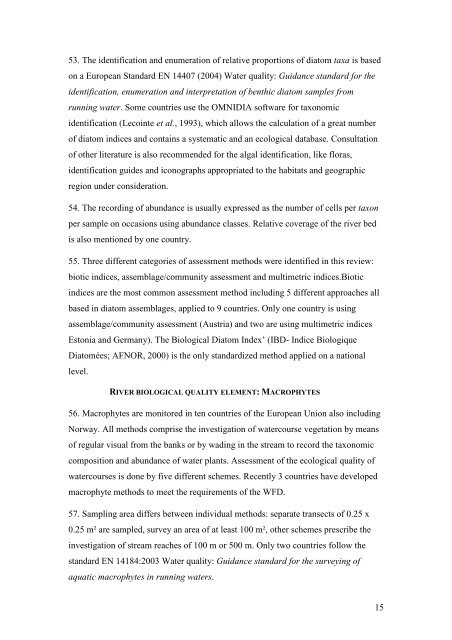Report on Harmonisation of freshwater biological methods
Report on Harmonisation of freshwater biological methods
Report on Harmonisation of freshwater biological methods
You also want an ePaper? Increase the reach of your titles
YUMPU automatically turns print PDFs into web optimized ePapers that Google loves.
53. The identificati<strong>on</strong> and enumerati<strong>on</strong> <strong>of</strong> relative proporti<strong>on</strong>s <strong>of</strong> diatom taxa is based<strong>on</strong> a European Standard EN 14407 (2004) Water quality: Guidance standard for theidentificati<strong>on</strong>, enumerati<strong>on</strong> and interpretati<strong>on</strong> <strong>of</strong> benthic diatom samples fromrunning water. Some countries use the OMNIDIA s<strong>of</strong>tware for tax<strong>on</strong>omicidentificati<strong>on</strong> (Lecointe et al., 1993), which allows the calculati<strong>on</strong> <strong>of</strong> a great number<strong>of</strong> diatom indices and c<strong>on</strong>tains a systematic and an ecological database. C<strong>on</strong>sultati<strong>on</strong><strong>of</strong> other literature is also recommended for the algal identificati<strong>on</strong>, like floras,identificati<strong>on</strong> guides and ic<strong>on</strong>ographs appropriated to the habitats and geographicregi<strong>on</strong> under c<strong>on</strong>siderati<strong>on</strong>.54. The recording <strong>of</strong> abundance is usually expressed as the number <strong>of</strong> cells per tax<strong>on</strong>per sample <strong>on</strong> occasi<strong>on</strong>s using abundance classes. Relative coverage <strong>of</strong> the river bedis also menti<strong>on</strong>ed by <strong>on</strong>e country.55. Three different categories <strong>of</strong> assessment <strong>methods</strong> were identified in this review:biotic indices, assemblage/community assessment and multimetric indices.Bioticindices are the most comm<strong>on</strong> assessment method including 5 different approaches allbased in diatom assemblages, applied to 9 countries. Only <strong>on</strong>e country is usingassemblage/community assessment (Austria) and two are using multimetric indicesEst<strong>on</strong>ia and Germany). The Biological Diatom Index’ (IBD- Indice BiologiqueDiatomées; AFNOR, 2000) is the <strong>on</strong>ly standardized method applied <strong>on</strong> a nati<strong>on</strong>allevel.RIVER BIOLOGICAL QUALITY ELEMENT: MACROPHYTES56. Macrophytes are m<strong>on</strong>itored in ten countries <strong>of</strong> the European Uni<strong>on</strong> also includingNorway. All <strong>methods</strong> comprise the investigati<strong>on</strong> <strong>of</strong> watercourse vegetati<strong>on</strong> by means<strong>of</strong> regular visual from the banks or by wading in the stream to record the tax<strong>on</strong>omiccompositi<strong>on</strong> and abundance <strong>of</strong> water plants. Assessment <strong>of</strong> the ecological quality <strong>of</strong>watercourses is d<strong>on</strong>e by five different schemes. Recently 3 countries have developedmacrophyte <strong>methods</strong> to meet the requirements <strong>of</strong> the WFD.57. Sampling area differs between individual <strong>methods</strong>: separate transects <strong>of</strong> 0.25 x0.25 m² are sampled, survey an area <strong>of</strong> at least 100 m², other schemes prescribe theinvestigati<strong>on</strong> <strong>of</strong> stream reaches <strong>of</strong> 100 m or 500 m. Only two countries follow thestandard EN 14184:2003 Water quality: Guidance standard for the surveying <strong>of</strong>aquatic macrophytes in running waters.15














![Accommodation booking form [PDF]](https://img.yumpu.com/39471785/1/184x260/accommodation-booking-form-pdf.jpg?quality=85)

